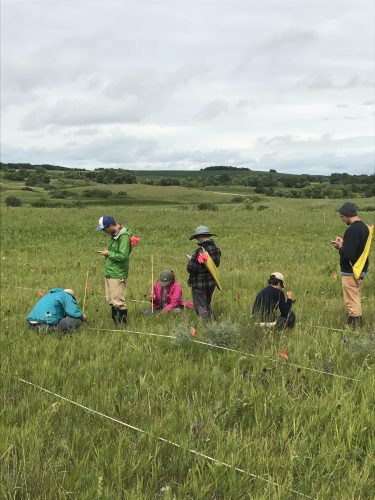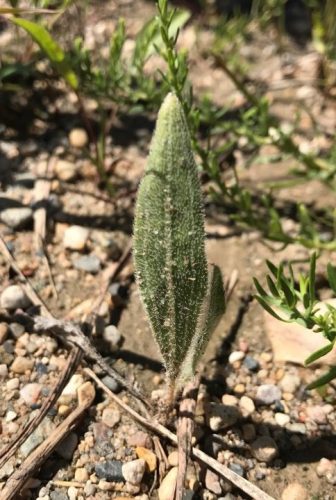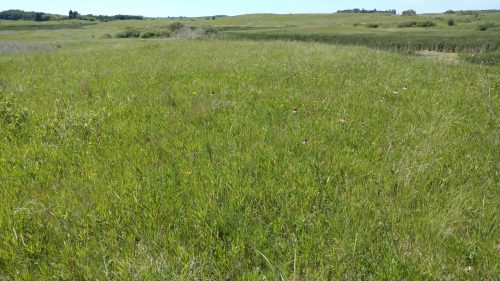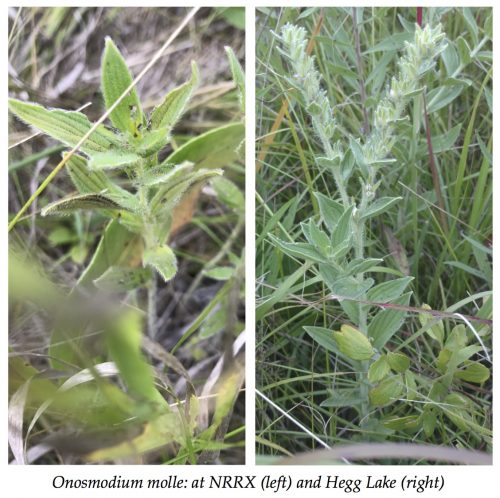|
|
This summer, we measured open-pollinated hybrid Echinacea plants in experimental plot 9 at Hegg Lake. The table below shows the number of plants found alive during each search since the experiment started in 2014. Of the surviving plants in 2017, 90% had fewer than 3 leaves, the mean length of the longest basal leaf was 25 cm, and only six plants had more than one basal rosette. This year we searched for plants once then rechecked every position where we didn’t find a plant during our first search. No plants flowered this year.
| Year / Event |
Number Alive |
% Original remaining |
% Of previous year |
| Planting (2014) |
746 |
100 |
|
| 2014 |
638 |
85.5 |
85.5 |
| 2015 |
521 |
69.8 |
81.7 |
| 2016 |
493 |
66.1 |
94.6 |
| 2017 |
401 |
53.8 |
81.3 |
This experiment comparing the fitness of Echinacea hybrids with pure-bred E. angustifolia and E. pallida will give insight into the possible consequences of non-native E. pallida being planted in restorations in Minnesota, where E. angustifolia is the only native Echinacea.
 Measuring at Hegg Lake Start year: 2014
Location: Hegg Lake Wildlife Management Area — experimental plot 9
Overlapping experiments: Echinacea hybrids — experimental plot 6, Echinacea hybrids — experimental plot 7
Data collected: Rosette number, length of all leaves, herbivory for each plant collected electronically and exported to CGData. Recheck information for plants not found was also collected electronically and stored in CGData.
You can find out more information about experimental plot 9 and flog posts mentioning the experiment on the background page for the experiment.
This summer, we measured hybrid Echinacea plants in experimental plot 7 at Hegg Lake. 159 of the original 294 planted seedlings (54%) were found this year. We searched 243 of the 294 positions where plants were originally planted (the other 51 positions were not searched because plants have not been found for at least three years in a row). The table below shows the fate of plants in 2017 summarized by cross-type — the first name in the cross type is the maternal species, and the second name is the paternal species (e.g., ‘ang x pal’ is angustifolia mother and pallida father).
| Status 2017 |
ang x ang |
ang x pal |
pal x ang |
pal x pal |
| not found |
53 |
10 |
33 |
35 |
| found |
21 |
18 |
52 |
72 |
 Flowering Echinacea angustifolia. Start year: Crossing in 2012, Planting in 2013
Location: Hegg Lake Wildlife Management Area – Experimental Plot 7
Overlaps with: Echinacea hybrids: ex Pt 6; Echinacea hybrids: ex Pt 9
Data collected: Rosette number, length of all leaves, herbivory for each plant collected electronically and exported to CGData. Recheck information for plants not found was also collected electronically and stored in CGData.
Products: Taylor Harris’s 2015 poster demonstrating fitness benefits of pallida parenthood.
You can find more information and links to previous flog entries involving experimental plot 7 on the background page for the experiment.
In 2017, we searched for 56 of the original 66 Echinacea hybrid plants. We found 28 Echinacea hybrids, and 2 of the Echinacea hybrids we found just had dead leaves from this year. This means that 42% of the original cohort is still alive, with the survival rate this winter of 78%. Of the surviving plants, the highest leaf count was 5 leaves, the longest basal leaf was 35cm, and only one plant had more than one basal rosette.
 Most plants we measured in exPt6 looked like this. This plot was originally developed for Josh Drizin’s experiment with exotic grasses, but 66 hybrids of Echinacea angustifolia and Echinacea pallida were also planted in 2012. In 2011, Gretel and Nicholas Goldsmith performed reciprocal crosses between 5 non-native pallida plants found at Hegg Lake and 31 angustifolia plants in P1. These plants have been revisited each summer since then.
Year started: Crossing in 2011, planting in 2012
Location: Experimental Plot 6, on Tower Road
Overlaps with: Echinacea hybrids — ex Pt 7, Echinacea hybrids — ex Pt 9
Data collected: Status, rosette count, longest leaf measurement, and number of leaves for each plant. Exported to CGData.
Products: Nicholas Goldsmith wrote a summary of the crosses he conducted in 2011.
You can find more information about experimental plot 6 and previous flog posts about it on the background page for the experiment.
In 2017, we searched in 7 recruitment plots for flowering Echinacea angustifolia plants. For each flowering plant, we took demographic data- counting the number of rosettes, counting the number of flowering heads, and shooting a GPS point of the exact location of the plant. Four plots had no flowering plants, but three of the plots had a total of 43 flowering Echinacea plants. Of the plots with flowering plants, two plots (with 35 of the flowering plants) are located at Hegg Lake, a site managed by the Minnesota DNR, and one plots (with 8 flowering plants) is located at Eng Lake.
This recruitment experiment was originally established in 2000 to quantify seedling emergence and juvenile survival of Echinacea angustifolia during its reintroduction to sites with varying land-use history and burn schedules. Before 2014, detailed data was collected on each plant in the plots. Since 2014, we’ve censused each plot yearly to collect demographic data for every flowering plant.

Echinacea at Hegg Lake, photo by Wes Braker
Year started: Plantings in 2000-2002
Location: Ten study plots on state land with different land use histories: old-field and restored grassland.
Overlaps with: Demographic census in remnants
Data collected: Status, rosette count, flowering head count, GPS point for each flowering plant in each recruitment plot
Products:A paper (Wagenius et al. 2012) published in Restoration Ecology.
You can find more information about the effects of fire on seedling recruitment of Echinacea angustifolia on the background page for the experiment.
 Flowering Solidago speciosa at Staffanson Prairie Preserve. In the summer or 2017, Lea repeated her observational study quantifying flowering phenology and reproductive success (seedset) for Liatris aspera and Solidago speciosa plants located along a transect at Staffanson Prairie Preserve. Staffanson is divided into east and west units. The west unit of Staffanson was burned Spring 2016. In 2016, Lea looked for differences in phenology and reproduction of east vs. west Liatris and Solidago plants. In 2017, neither unit was burned. Data collected this year combined with data collected in 2016 will enable us to to see if burns influence phenology or reproduction. To assess phenology, Lea visited plants three times a week and recorded if they were flowering. She took GPS data for each plant included in the study. To assess reproduction (seedset), plants were harvested and brought back to the Chicago Botanic Garden so that seeds could be removed from the plant and x-rayed. This study helps us understand how fire, phenology, and reproduction are linked in species that are related to Echinacea angustifolia.
Start year: 2016
Location: Staffanson Prairie Preserve
Overlaps with: Fire and fitness of EA, Flowering phenology in remnants
Physical specimens:
- 70 harvested Liatris aspera specimens from summer 2017, located at the CBG
- 70 harvested Solidago speciosa specimens from summer 2017, located at the CBG
Data collected: Phenology data was taken on the visors every Monday, Wednesday, and Friday through the growing season. Paper harvest data sheets were used and will remain in Minnesota until the final harvest of the season.
GPS points shot: ~140 new GPS points were shot, one for each plant monitored in summer 2017 and ~180 points were staked to revisit plants that flowered last year. For each point staked, the plant status was recorded as either basal, flowering, or not present.
 Successful pollination leads to full achenes and higher fitness later in the season! This summer we counted shriveled and non-shriveled rows of styles three times per week for every Echinacea head in 8 of the 28 remnant populations. We also harvested 121 Echinacea heads to be analyzed for seedset data. This year we selected heads for harvest based on their position within randomly selected plots where Tracie Hayes and Lea Richardson collected vegetation data. In every randomly selected vegetation plot, all species were identified and we recorded their abundance. We marked any Echinacea head within a vegetation plot for harvest. Harvested heads are ready to be processed by citizen scientists at the Chicago Botanic Garden. In the lab, heads will be cleaned so that all achenes can be counted and x-rayed to determine seedset.
Measuring the reproductive success of an Echinacea angustifolia head gives insight into the fitness of the individual. In remnant populations, we measure reproductive success using two methods: style persistence and seedset. Seedset is the proportion of all seeds that are viable in an Echinacea head, and is measured in the lab after heads have been harvested. Style persistence is a fitness measure that can be taken during the field season. Styles, the showy female reproductive structures that emerge from every floret in an Echinacea head, shrivel within 24 hours if they receive compatible pollen. Keeping track of how many styles shrivel and how many persist can give us a sense of the reproductive success of that head without any lab work.
Year: 1996
Location: Roadsides, railroads and rights of way, and nature preserves in and near Solem Township, Minnesota.
Overlaps with: flowering phenology in remnants, mating compatability in remnants
Physical specimens: 121 harvested heads, currently at the Chicago Botanic Garden
Data collected:
- Style persistence data for each flowering head, collected three times per week, stored in remData
- Dates and identities of harvested heads, stored on paper datasheets entered electronically into richHood
GPS Points Shot: A point for each flowering head, stored under PHEN and SURV records in GeospatialDataBackup
Products:
You can find out more about reproductive fitness in the remnants and read previous flog posts about it on the background page for the experiment.
Today was a long but productive day. We started the morning getting trained in on seedling refinds. Although this particular task can be time-consuming, the pay off is great for data. By revisiting seedlings that were first found between four and seven years ago (and have been found every years since), we are able to better understand what the early life of an Echinacea plant is really like! Ruth, who came out to do fieldwork with us today, explained how the data we collect on these seedlings can be used with Aster modeling, and result in some pretty interesting scientific knowledge. This morning, we did all the seedling refinds at East Elk Lake Road. After lunch, and some delicious chocolate provided by Ruth, we headed out to complete a variety of tasks. Tracie and I went to Staffanson to look at the phenology of my Solidago and Liatris plants. After that, went to twenty different Echinacea plants at eight different sites, and completed plant community surveys within 4 square meters of each plant. We worked until about 6:30, then headed back to Andes for a delicious dinner and some much needed relaxation.
 Recognize this unusual-looking specimen?
Today we had a productive day! We started the day with staples and re-checks in p1, which as Will remarked today could at times be called, “pool 1”. Indeed, my pants were wet from boot to waist, and it took a few hours to dry off completely. After rechecks, we worked on computer work until lunch. It was at that point that 4 peach day passed and 3 peach day began. We measure days in peaches, Ashley’s peaches to be exact- never Alex’s peaches. It was also at lunch that I received a very clear notification regarding my flogging responsibilities, posted below.
 Look how confusing! After lunch, we spend a few hours working on independent projects. Tracie, Gretel, Kristen, and I headed to NRRX and RRX to work on some vegetation analysis. It was nice having Gretel, the local plant ID expert, help us with the data collection. Kristen also was a great help, she’s learning the Visor skills at lightening speed. Meanwhile, the rest of the team finished demo at RRX, and everyone had some independent project time. An interesting coincidence happened this afternoon- both Wes and I had a question about the identity of the same plant species. We both took photos, and luckily Gretel was able to help. Even with all of Gretel’s great clues about the ID, (“the epithet is a sauce you’ve made”) I couldn’t get it on my own and had to be told the ID!

Overall it was a great day, and I can only hope that the remainder of 3 peach day goes as nicely!
 Ashley finds another Monarch caterpillar at Nice Island!
Today was a nice cool and rainy day in Minnesota. I spent the day cooking and hanging out with the dogs while people went out and did various chores for the weekend. Wes played in a very rainy parade, too! We also got Andes all cleaned up and ready for Kristen! Kristen arrived around dinner time and we are all very excited that she’s joining the team this week! It will be nice to have a new team-member for the last third of the summer. All in all it was a nice relaxing weekend day, and the weather was beautiful even though it was very wet.
 Rocks in the rain at Andes
What phenology means to you (in 5 words or less):
“16/10 first day, great job!”
-Wesley Braker
“Around Landfill, Monarch caterpillars”
-[possibly Anna Vold]
“one two zero one seven”
-Alexander Hajek
“Never red, white, and clear.”
-William Reed
“I’ll do the Nessman loop”
-Lea Richardson
“That’s a nice Echinacea”
-Tracie Hayes
“Let’s check the decision tree!”
-A. Barto
“This one’s not twist-tied!”
-Gretel Kiefer
“Active searching, turn your head”
-[likely Stuart]
|
|











